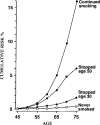Models of carcinogenesis: an overview
- PMID: 20430846
- PMCID: PMC3025741
- DOI: 10.1093/carcin/bgq087
Models of carcinogenesis: an overview
Abstract
At least five coherent models of carcinogenesis have been proposed in the history of cancer research in the last century. Model 1 is mainly centered around mutations, and its main focus is on the chemical environment, radiation and viruses. Model 2 has to do mainly with genome instability and it focuses on familiality. Model 3 is based on non-genotoxic mechanisms, and clonal expansion and epigenetics are its main features. We propose a fourth model, which can encompass the previous three, based on the concept of a 'Darwinian' cell selection (we clarify that the term Darwinian needs to be used cautiously, being a short cut for 'somatic cellular selection'). Finally, a fifth model has recently become popular, based on the concept of 'tissue organization'. We describe examples of the five models and how they have been formalized mathematically. The five models largely overlap, both scientifically and historically, but for the sake of clarity, it is useful to treat them separately. We also argue that the five models can be included into a simpler scheme, i.e. two types of models: (i) biological changes in the epithelium alone lead to malignancy and (ii) changes in stroma/extracellular matrix are necessary (along with changes in epithelium) for malignancy. Our description, though simplified, looks realistic, it is able to capture the historical sequence of carcinogenesis theories in the last century and can serve as a frame to make research hypotheses more explicit.


